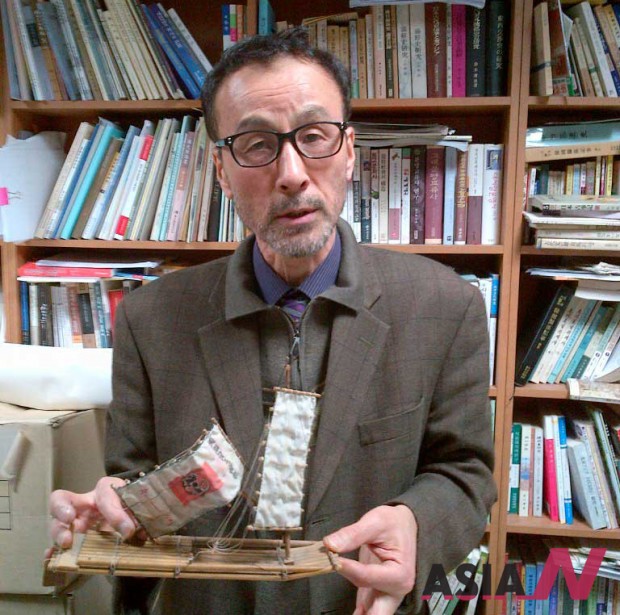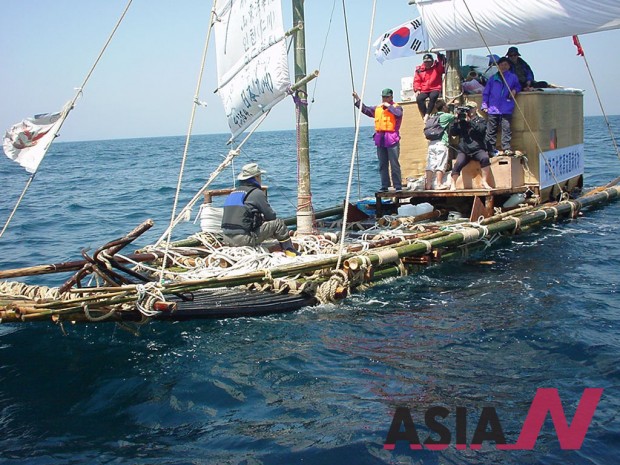Koreans to challenge seemingly impossible voyage on raft
Five Korean adventurers will set sail in May on a seemingly impossible voyage from the Philippines to South Korea on a bamboo raft propelled only by the wind and ocean currents.
The raft, to be christened “East Asian Civilization III,” will mark the latest effort by Prof. Youn Myung-chul of Dongguk University to demonstrate a historic maritime connection between Korea and the people of Southeast Asia.
“I have conceived the voyage in order to confirm the common identity of Asian people and seek a civilization of harmony and coexistence among the people of the region,” said Youn, who has led four similar expeditions along routes connecting South Korea, China and Japan.
“To be more specific, there are historic signs showing the vestige of Southeast Asian civilization in our country. The voyage will prove the possible maritime route through which the civilization was transmitted to here,” Youn said in an interview with the AsiaN on April 6.
The 59-year-old scholar-adventurer explained that the raft will be made in the Philippines using bamboo. His specifications call for a vessel 15 meters long and 6 meters wide. It will leave Laoag, the Philippines, in early May for the southern port city of Yeosu, South Korea.
He expects to arrive around the middle of June by taking a route passing Taiwan, Okinawa and Cheju Island before reaching Yeosu.
The raft will be powered by three sails 16 meters long and six meters wide, and it will move at a speed of about 2 kilometers an hour. The route is about 2,000 kilometers long in a straight line, but the actual navigating distance is expected to exceed 4,000 kilometers. The voyage should take about 50 days, although it could be shortened to 30 to 40 days with favorable wind and weather conditions, according to Youn.
This will not be his maiden adventure on a raft. He has successfully finished similar voyages four times, in 1983, 1996, 1997 and 2003. His first voyage, made when Youn was 28, was between Geojedo, southern port city of South Korea and Tsushima, Japan, covering about 50 kilometers.
Through his previous voyages, he was able to develop an academic area of study called East Asian maritime history. He has proposed a new theory called the “East Asian Mediterranean,” claiming that the Yellow Sea and the South China Sea served as the Mediterranean for East Asian countries, making it possible to have an active exchange of commodities and civilizations among those in the region.
He explained that the vessel will be safer than people may believe.
“People don’t know well about the fact that a raft is safer than an ordinary ship in a long-range voyage. The bottom of raft is in full contact with the sea, so it is hard to be capsized under any weather conditions.
“The raft becomes one with the sea and moves at the pace of nature. Of course, it rattles hard in rough waves, but the crew can remain safe by fastening themselves with a rope attached to the raft,” he said.
The vessel will weigh about 500 kilograms. It will have a cabin and be equipped with top-notch electronic gadgets, including GPS and communication facilities, a cabin and a payload of about 2.5 tons.
“Another important thing I want to show through the voyage is the worthiness of being slow. It moves at a snail’s pace, slower than that of people walking.
“The kind of things people do on it are quite limited. Except for eating, sleeping, excreting and [the crew] talking among themselves, there is nothing else but to watch an ocean in the daytime and look up at the stars at night,” he said.
“However,” he said, “the environment leads people to lose themselves in thought and makes them feel at ease. Sitting alone deep at night brings absolute loneliness and makes me feel one with the sea and nature.”
The sea doesn’t always remain calm and gets angry from time to time, driving people to the crossroad of life or death, Youn said. It is difficult to remain calm at the height of a storm, when gusting wind can blow away people and the boat itself. He said he expects to encounter such extreme conditions once or twice during the long voyage.
“Our state of mind can be changeable depending on how we think. Once we get overwhelmed by fear, the sense of terror attacks us incessantly. I always try to think of something bright. Adventure is an act of challenging extreme situations. Overcoming brings us a keen pleasure,” he went on to say.
Though equipped with rudder, it is hard to steer a raft to a coast full of rocks. It is not too much to say that most of the mishaps involving a raft come at this time, he said.
The crew includes Ahn Dong-ju, researcher at the Korea Sea-Culture Institute, Choi Yun-su and Park Jung-bin, both members of the Dongguk University cave exploration team as well as Choi Se-yong, a cameraman.
The expedition is also aimed at publicizing the Yeosu Expo to be held from May 12 through Aug. 12.
Kim Nam-ju david9303@theasian.asia





























































Pingback: [The AsiaN Video for Chinese] 尹明喆教授的“东亚地中海文明理论”与竹筏探险 | THEAsiaN China